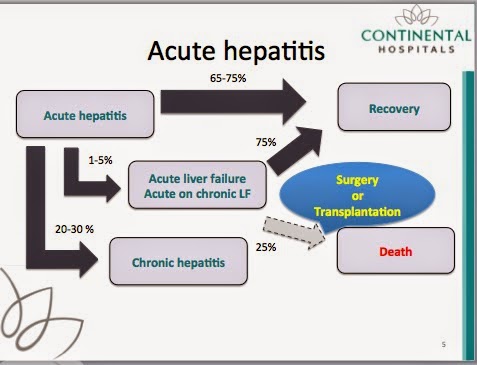Wonder Hepatitis C drug almost here.....at 99% reduced price
Hepatitis C is a viral disease that mainly affects the liver and is transmitted parenterally ( through contaminated blood products, syringes etc), vertically (from mother to child in womb) and sexually.More than 40% of patients infected with the virus develop chronic infection because the body is unable to eliminate the virus from the system.
Progression of chronic hepatitis is usually slow and culminates within 10-20 years of acquiring infection into cirrhosis and chronic liver failure that may be fatal without transplantation. About 4 out of every 100 patients with cirrhosis due to hepatitis C develop cancerous growths (hepatocellular carcinoma) in the liver that significantly reduces their survival. Alcoholism, obesity, diabetes mellitus, immunosuppressive medication and HIV infection are risk factors for early progression of chronic hepatitis to cirrhosis and liver failure.
In the absence of a reliable vaccine, treatment of chronic hepatitis C has so far yielded less than optimal results (40-55% sustained viral response). Silent undetected progression of disease, multiple genotypes of virus and poor tolerance of patients to medications ( particularly those with cirrhosis) contribute to the poor response.
Inability of cirrhotic patients to tolerate medications and reduced effectiveness results in most patients having detectable virus in blood at time of transplantation. Reinfection of new liver occurs within hours of transplantation and inflammation of graft starts weeks to months after transplantation depending on various factors like viral load, type of liver graft, immunosuppression, age and other factors. Post transplant recurrence of hepatitis C is more difficult to treat due to the presence of immunosuppression and sustained virological response is between 15-50% in various studies. A significant number of patients may need a second graft between 5-25 years after transplantation for recurrence of hepatitis C and cirrhosis.
Treatment of chronic hepatitis C has hinged on mainly two drugs: the antiviral drug Ribavarin (RBV) and the immunobodulator drug Interferon (IFN). Most regimens for treatment of hepatitis B include RBV and IFN (usually in pegylated form). Genotype 1 infection in particular has significantly poor response to PEG-IFN and RBV. Recently it has been identified that those patients that have infection with CC subtype of IL28 gene has double the response when compared to CT or TT genotypes.
Further research into HCV treatment resulted in a new class of molecules called Protease inhibitors that inhibit viral enzymes
Bocepravir and Telaprevir were the first generation of protease inhibitors introduced for management of chronic hepatitis in untreated as well as previously treated patients with chronic HCV and compensated cirrhosis. Addition of a protease inhibitor to combination of IFN & RBV significantly increased the sustained viral response rate ( by 15-30%) for difficult to treat genotype 1 patients over IFN&RBV alone except in treatment experienced patients who were null responders. Monotherapy is not recommended because rapid resistance results.
Simepravir (SPV) is a second generation protease inhibitor effective against HCV introduced about a year ago. It is never used a monotherapy. For genotype 1 a patients , SPV in combination with IFN & RBV for both treatment naive and experienced patients with genotype 1 infection. It can also be effective in combination with RBV and Sofosbuvir for patients who cannot tolerate toxic IFN therapy. SPV based triple therapy is a superior alternative to first generation protease inhibitors and is better tolerated. It can also be used as an alternative to Sofosbuvir in combination with a longer course of IFN & RBV. One of the main disadvantages in the high cost .....about 70000 USD ( approximately Rs 43 lakh) for a 12 week course.
Sofosbuvir (SBV) is also a polymerase inhibitor effective against HCV introduced about a year ago. It is effective for all genotypes of HCV but FDA approved only for 1,2,3 &4. It can be used with RBV with or without PEG-IFN and has shown promise in treatment naive, experienced as well as HIV coinfected patients of chronic hepatitis C and compensated cirrhosis. It has high acceptability due to fewer side-effects and interactions, once daily dosing and pan-genotypic activity. For genotypes 2 & 3 an all oral regimen of SBV and RBV is effective. For 1,3,4 & 5 genotypes addition of PEG-IFN is recommended but for those who cannot tolerate IFN, combination of SBV,SMV with or without RBV is showing promise.
Therefore Sofosbuvir is considered a breakthrough wonder drug for HCV currently and is expected to figure in more and more regimens for HCV. The prohibitive cost of 84000 USD ( 55 lakh INR) has been the main deterrent in greater availability and application of the drug even among insured patients in the western world. The greatest benefit of SBV seems to be in genotype 1 patients which accounts for more than 60% patients in the USA. SBV monotherapy was effective in more than 70% patients in achieving SVR while in combination with IFN & RBV the SVAR rate was more than 90% even among null-responders.
In India the prevalence of HCV is between 3-5 % of the population with 20-25% of patients with chronic liver disease being due to HCV infection. Genotype 3 is the commonest in India (66%) while Genotype 1 is less common (13%).








